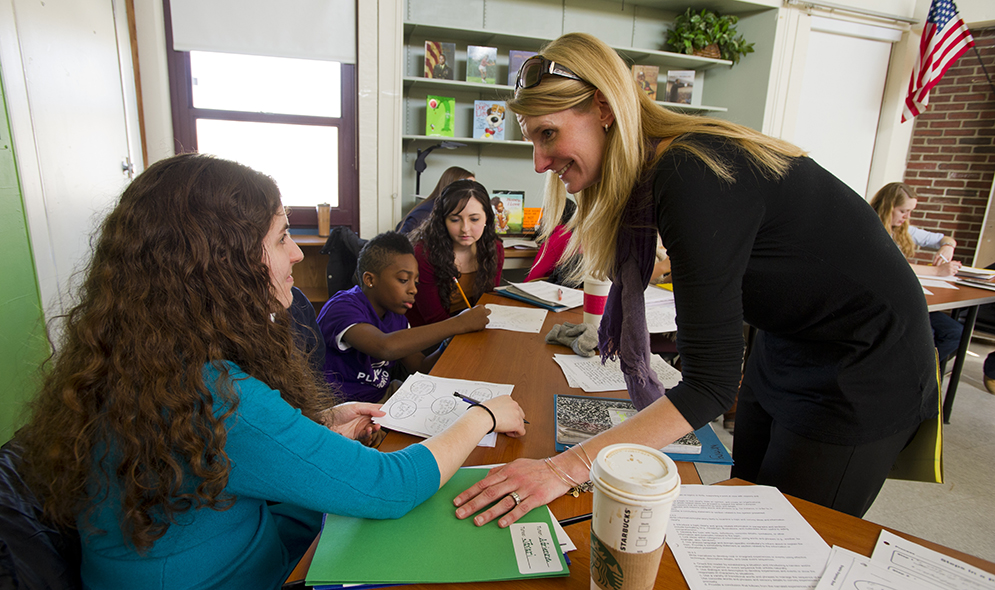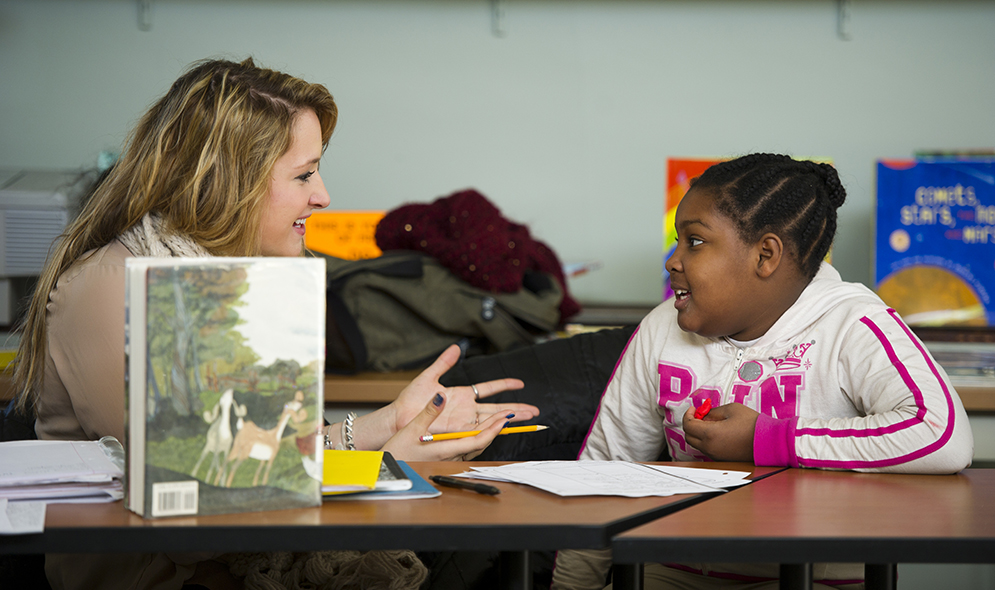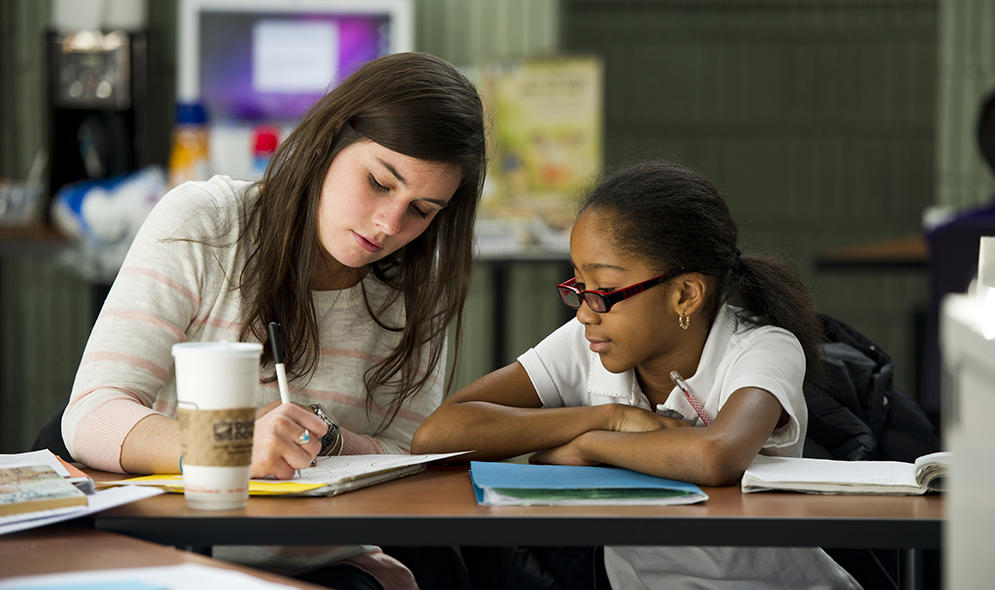BU-Trotter Partnership Shines in Dorchester
SED students gain urban ed experience, children grow with individual tutoring

Shannon Sheridan (SED’15) (right) and AnneMarie Schiller (SED’15) (center) help Trotter fourth graders with instructions for a motion experiment. Photos by Cydney Scott
Veteran science teacher Brenda Richardson has 30 minutes to deliver her lesson to a classroom full of kinetic fourth graders, two still in cool-down mode after a brief scuffle. It’s enough to bring sweat to the palms of the dozen BU School of Education students observing Richardson’s every move from the back of the room at the William Monroe Trotter Innovation School in Dorchester.
Over the light chatter and low din of chairs scraping the tile floor, Richardson reads from a poster titled Motion and Design: “When a vehicle is at rest…” Here she pauses and asks, “What do I mean by ‘vehicle’?”
A small hand rises and an eager boy answers: “Vehicle means your car.”
“Yes,” nods Richardson. “It’s just another word for your car.” She reads the rest of the poster, then tells the students to divide into groups and start assembling cars with the string, paper clips, and washers ready for them to use for their experiments.
At Richardson’s instruction, the SED students disperse among the groups. One by one, they squat down to guide the young scientists through the exercise, and cars soon scoot, or creep, across the tables pulled by the weight of attached washers. While Richardson weaves from one group to the next to dish out encouragement, students pull her aside to show off their good work.
“You have done an awesome, awesome job,” Richardson says as she wraps up the class, spotting principal Mairead Nolan and assistant principal Romaine Mills-Teque at the door. The administrators usher the children away for a quick conversation about the earlier scuffle, leaving the SED students alone with their Trotter mentor.
“That’s exactly what I want you to do every time you come,” Richardson says. “All of you weren’t afraid to just jump right in.”
Richardson is accustomed to BU students in her classroom. In 2006, Thomas M. Menino (Hon.’01), former longtime Boston mayor and now codirector of BU’s Initiative on Cities, created a program called Step UP, which charged 5 local universities with assisting 10 public schools struggling to meet the goals of the federal No Child Left Behind act. Charles Glenn, then SED dean ad interim, chose the Trotter and the English High School of Boston—the two lowest performers at the time.
Working closely with Trotter staff, SED developed courses that place elementary education undergraduates in the public school’s reading, writing, and science classes at several grade levels. Teachers and professors swap methods and coteach, while SED students observe and tutor children. A BU-initiated program, Dads Read, encourages fathers to pick up a book with their children after school. And the Boston University Initiative for Literacy Development gives work-study students the opportunity to provide additional afternoon tutoring.

Jennifer Bryson (right), an SED clinical instructor and director of the SED Elementary Education program, and SED tutor Adrienne Cytto (SED’15) (left) during a writing session at Trotter.
The partnership between SED and the Dorchester elementary school deepened when Trotter was designated by the Massachusetts Department of Elementary and Secondary Education (DESE) as Level 4 in 2010 and put under the state’s watchful eye. The Level 4 designation means it was among the state’s most struggling schools based on MCAS trends over four years. The designation was a blow, but it gave Nolan permission to rebuild her staff and invest in professional development. She also informed SED that improving children’s literacy was the area where her school could use the most help.
Nolan’s all-out push made a difference. Trotter students’ consistent gains on the MCAS lifted the school last year to Level 1 status, meaning all students met the state’s gap-narrowing goals—rarified air occupied by schools in affluent suburbs like Wellesley and Newton. The difference, however, is that Trotter has farther to climb to the top of the MCAS performance ladder. The school still ranks among the state’s lowest performers (in the 21st percentile). At the same time, it has become a beacon among high-poverty peers. Nearly 84 percent of Trotter’s 400 children come from low-income families, compared to a statewide average of 38 percent, according to the DESE.
Trotter: founded on mission of racial integration
BU officials do not take credit for Trotter’s success. SED Dean Hardin Coleman goes so far as to say that the University has helped to facilitate the school’s progress, similar to Gatorade-toting sidekicks to Nolan’s forward-charging football team. “We’re not being falsely modest by saying she was the leader” in creating a coherent culture and curriculum, he says. “We provided useful and timely help to those efforts.”
As far as the SED dean is concerned, that’s all for the good. “It’s essentially vital that universities share their cultural capital with the community,” says Coleman, who was appointed by Menino last summer to the Boston School Committee. “These are the kids that we want to recruit to come to us one day.”
Named after civil rights activist and Hyde Park native William Monroe Trotter, the school opened its doors in 1969 as Boston’s first magnet school. It was founded on the mission of racial integration—well before the city’s tumultuous implementation of court-mandated school desegregation and forced busing in 1974. At the time, it boasted a 60 to 40 percent split between black and white students and was a first pick for many families, whose “kids came from all over the state,” says Alma Wright, a computer specialist who helped open the Trotter.
The school and the neighborhood around it fell into sharp decline in the late 1980s. Wright says its quality of instruction dropped as many African American teachers were moved to other districts to meet desegregation goals. Drugs and gang violence transformed the neighborhood surrounding Humboldt Avenue, the school’s base, into a danger zone that many families—mostly white—fled for calmer suburbs. The school is now 60 percent African American, 30 percent Hispanic, and 6 percent white.
By the end of 2009, MCAS scores had plummeted. Only 13 percent of Trotter’s third, fourth, and fifth graders scored proficient or higher in English and 12 percent in math.
Around that time, Carol Jenkins, an SED associate professor in the Elementary Education program and a Metcalf Award winner last year, was growing frustrated with the University’s teacher preparation methods, which had students listening to lectures and role-playing classroom situations on the Charles River Campus. “They need to be in classrooms with real teachers,” she remembers thinking. “They need to observe me teaching too.”

Emily Chessher (SED’15) shares a story and a laugh with a Trotter fourth grader.
Recent SED graduates had the same opinion. One alumna placed in a New York City school told Jenkins that she felt unprepared, despite being one of the highest performers in her class.
Coleman understands the problem. Most SED students, he says, come from suburban middle-class families with “good cultural capital,” yet their first job might be in an urban school where mentors and resources are scarce, families face unemployment and poor health care, and children come to school hungry and tired—situations most SED students were unlikely to encounter while practice teaching.
Jenkins thought SED needed to place greater emphasis on “situated learning” in urban schools, and the Trotter partnership was an obvious solution. She moved from occasionally coteaching fourth grade writing classes while her students observed to developing a semester-long methods course where her aspiring teachers coached children through the writing process.
Don DeRosa (SED’91,’01), an SED clinical associate professor of science education, joined Jenkins, pairing with Trotter’s Richardson so that his students could observe, coach, and occasionally lead science classes.
Jenkins recruited a sociology professor to teach a two-credit course for the SED students at Trotter that tackles topics like racial, cultural, gender, and social identities and how they relate to the achievement gap. A half-hour block is wrapped into each Monday and Wednesday class this year so that students can tutor second graders in poetry and hone the children’s literacy skills.
Giving tools to change the world
Tutoring children “definitely confirms that I want to be a teacher,” says Marina Alberti (SED’16). “They really count on you to be there each week.
SED students say their children bring them hand-drawn pictures, give them hugs—Gwen Jahnke (SED’16) fielded a tight squeeze from one of her students during a recent visit—and share stories about life at home. “Sometimes you have to tell them: ‘TMI,’” Megan Baker (SED’16) says with a laugh.
Donald Gillis (GRS’78,’14), a College of Arts & Sciences lecturer in sociology, and Chris Martell (SED’11), an SED clinical assistant professor of social studies in the Elementary Education program, coteach the sociology class, which Gillis calls a cultural awakening for many teachers-in-training. “We want them to change the world, but we need to give them the tools to do it,” says Martell, who thinks this class is a step in that direction.

Alison Brotmann (SED’15) works on a story outline with a Trotter fourth grader.
Across the hall from the sociology class, Elyssa Garcia (SED’15) sits beside a fourth grader, coaching him through a writing assignment about the “best time you ever had.” There’s a long pause before the reticent boy in a buttoned-down shirt and sneakers jots down his list: my birthday, vacation in Miami, basketball with my brother, seeing my father. He eventually chooses his 10th birthday, but gets stuck when Garcia asks him to divide up the day’s events.
“It’s kind of hard to think,” he says, barely above a whisper.
Garcia pries more information from her student. Soon, he’s filling a timeline describing a birthday whose main event was a new phone from his mom.
“Wow!” Garcia says. “You’re really writing a lot. This is going to be a good story. When we started, you said, ‘Oh, I don’t really have any best days.’”
Julia Badiali, the BU-Trotter partnership liaison, overhears their conversation as she circulates the room with Jennifer Bryson (SED’98,’05), an SED clinical instructor and director of the Elementary Education program. Badiali gently ribs the boy for his hesitation, then provides this advice: “Think about what you guys did today. That’s what you’ve got to do for yourself on your own.” She’s talking about the MCAS testing, which looms large in the months ahead.
A former Trotter fourth grade teacher, Badiali says new teachers often graduate unprepared, and acknowledges learning through trial-and-error her first year. That’s why she calls the BU-Trotter partnership priceless for SED students, who have many opportunities to teach before graduation.
Badiali is quick to point out how Trotter benefits too: “You can’t put a price on a child’s one-on-one instruction.”
And what do the kids think? One girl in Richardson’s fourth grade science class seems to think the partnership is a good deal. She confided to AnneMarie Schiller (SED’15) during their motion experiment: “I’ve never had a BU tutor. I’ve always wanted one.”
Comments & Discussion
Boston University moderates comments to facilitate an informed, substantive, civil conversation. Abusive, profane, self-promotional, misleading, incoherent or off-topic comments will be rejected. Moderators are staffed during regular business hours (EST) and can only accept comments written in English. Statistics or facts must include a citation or a link to the citation.